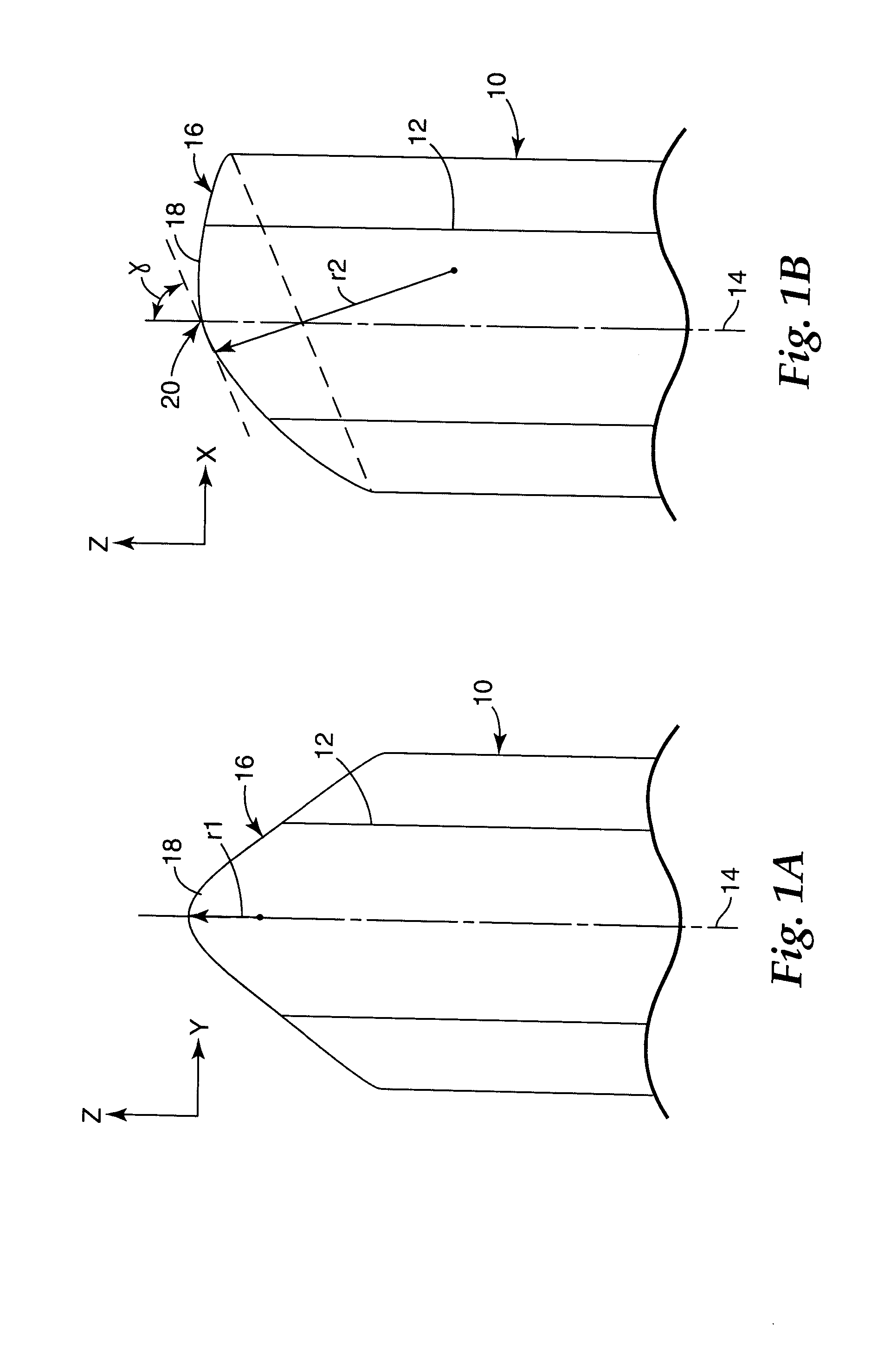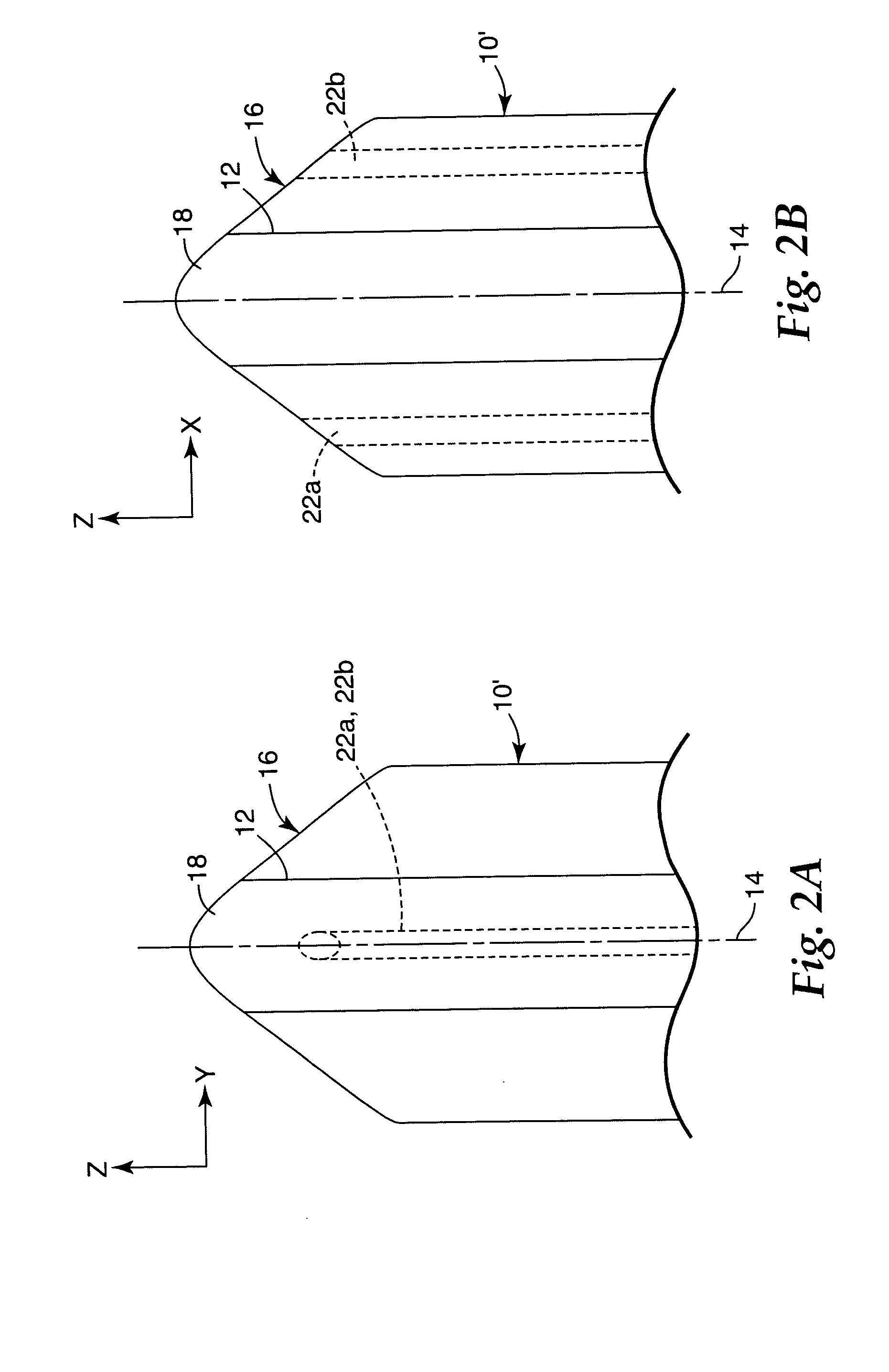Lensed optical fiber and method for making the same
- Summary
- Abstract
- Description
- Claims
- Application Information
AI Technical Summary
Benefits of technology
Problems solved by technology
Method used
Image
Examples
example 1
The creation of an angled toric lens with a large torus radius is illustrated in FIGS. 6 and 7A-7C. In this example, an optical fiber with isotropic physical properties was loaded into a collet, with the fiber protruding from the bottom face of the collet by 6.25 mm (0.246 inch). The fiber was drawn across abrasive lapping film in the curvilinear pattern as shown in FIG. 6. The collet to film distance was set at 5.00 mm (0.197 inch). The optical fiber was drawn in 400 cycles across a 0.5 μm diamond lapping film and then 100 cycles across a 0.1 μm diamond lapping film using the same pattern. It should be noted that the curvilinear pattern of FIG. 6 correctly shows the start and end points of the cycles, but the number of cycles illustrated has been reduced for clarity of the Figure. The optical fiber was then removed from the collet, placed in a fiber fusion splice, and subjected to three plasma bursts for 0.5 seconds each at a power setting of 11.5 mA to melt the tip of the lens. P...
example 2
The creation of an angled toric lens with a small torus radius is illustrated in FIGS. 8 and 9A-9C. In this example, an optical fiber with isotropic physical properties was loaded into a collet, with the fiber protruding from the bottom face of the collet by 6.25 mm (0.246 inch). The fiber was drawn across abrasive lapping film in the curvilinear pattern as shown in FIG. 8. The collet to film distance was set at 5.00 mm (0.197 inch). The optical fiber was drawn in 400 cycles across a 0.5 μm diamond lapping film and then 100 cycles across a 0.1 μm diamond lapping film using the same pattern. It should be noted that the curvilinear pattern of FIG. 8 correctly shows the start and end points of the cycles, but the number of cycles illustrated has been reduced for clarity of the Figure. The optical fiber was then removed from the collet, placed in a fiber fusion splice, and subjected to three plasma bursts for 0.5 seconds each at a power setting of 12.0 mA to melt the tip of the lens. P...
example 3
The creation of a conic lens on a fiber with anisotropic physical properties is illustrated in FIGS. 10A-B and 11. In this example, a PM optical fiber (Tiger fiber Type 7129 available from 3M Company of Saint Paul, Minn., U.S.A.) with anisotropic physical properties was loaded into a collet so that the fiber protruded from the bottom face of the collet by 6.25 mm (0.246 inch), with the major axis of the fiber stress ellipse loaded consistently in one direction. The fiber was subjected to a series of nine process stages consisting of drawing the fiber tip across flat abrasive lapping films in a series of true elliptical spiral patterns similar to those shown in FIGS. 10A and B.
The spiral paths used in each process stage are described by a set of X-Y coordinates referenced to an X-Y Cartesian coordinate system lying on the abrasive film. The Y-axis is defined as parallel to the major axis of the fiber stress ellipse as loaded into the collet. The set of X-Y coordinates describing t...
PUM
 Login to View More
Login to View More Abstract
Description
Claims
Application Information
 Login to View More
Login to View More - R&D
- Intellectual Property
- Life Sciences
- Materials
- Tech Scout
- Unparalleled Data Quality
- Higher Quality Content
- 60% Fewer Hallucinations
Browse by: Latest US Patents, China's latest patents, Technical Efficacy Thesaurus, Application Domain, Technology Topic, Popular Technical Reports.
© 2025 PatSnap. All rights reserved.Legal|Privacy policy|Modern Slavery Act Transparency Statement|Sitemap|About US| Contact US: help@patsnap.com



